Yellow Bells for Glorious Color Spring Through Fall
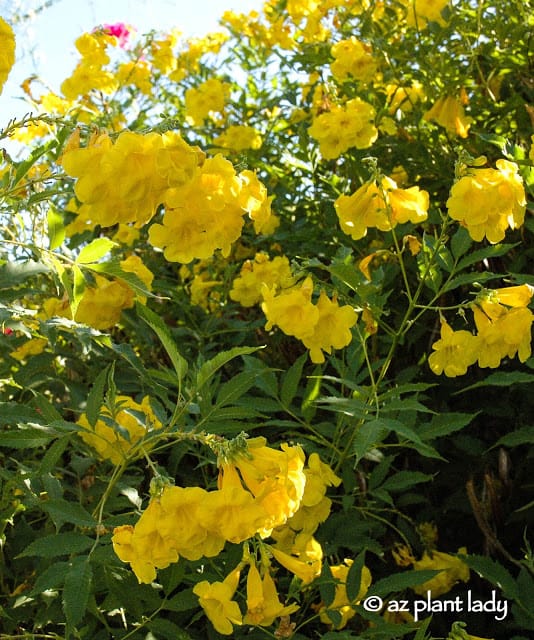
This beautiful plant is one of my favorite shrubs in the garden – so much so, that I have three. Yellow bells produce bell-shaped flowers beginning in spring and lasting through the fall months until the first frost.
Hummingbirds and butterflies are attracted to the flowers. The vibrant green foliage and colorful flowers make this shrub a welcome addition to any desert landscape.
Yellow Bells is a large shrub that grows to a height of 4 – 8 ft. and spreads 3 – 8 ft. wide. You can find its native habitat in the Americas. There are two different types; Tecoma stans angustata and Tecoma stans stans. Visually, the most significant difference is in the shape of the leaves. Tecoma stans stans had a broader leaf and are pictured above and below.
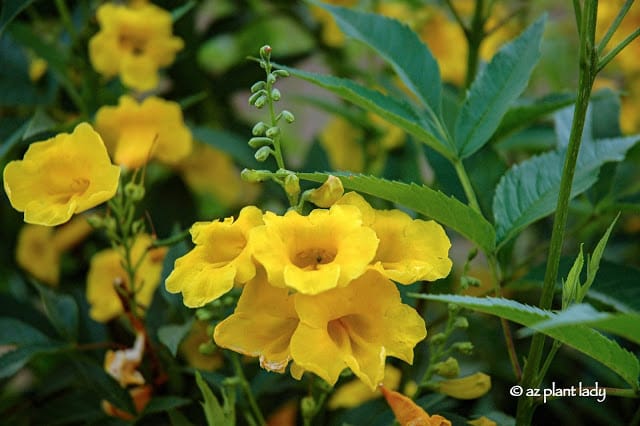
USES:
Because of its size, this large shrub makes a great backdrop plant. I have used it to screen fences, sheds and also planted it up against the house. Yellow Bells works well as a tall, naturally-shaped hedge. This shrub thrives in full sun to filtered shade. They do best in warm-winter areas but can be successful as a summer annual in colder regions.
MAINTENANCE:
This shrub is relatively low-maintenance. It will freeze back in the winter months when temperatures go below 28 degrees F. Since it blooms on current season’s growth, all that is required is to prune back the frost damage in early spring. Seed pods are produced and can be removed if desired, which will extend the bloom period and improve the appearance, (the seed pods do not bother me, and I do not remove mine). After an initial application of slow-release fertilizer when planting Yellow Bells, I have not needed to fertilize further.
**Occasionally, caterpillars will appear but can be easily removed by spraying some BT (Bacillus thuringiensis) which is an organic pesticide.
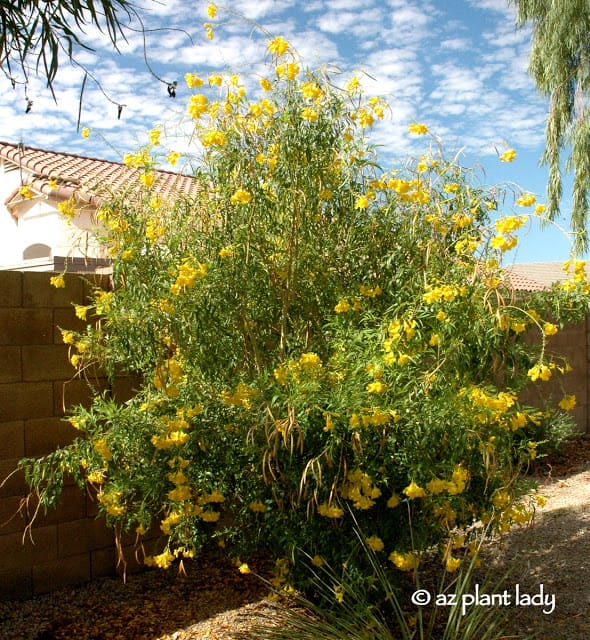
COMMON NAMES:
There are many familiar names for these beautiful shrubs. Tecoma stans angustata is native to the Southwestern US and northern Mexico and goes by the names Arizona yellow bells, yellow bells, and yellow trumpet bush.
Tecoma stans stans are native to Florida, the Caribbean and parts of South America and also goes by the name of yellow bells and sometimes yellow elder. Because of the overlap of familiar names, be sure to purchase plants based on their scientific name.
Fall Rose Tips for the Desert Garden

 Noelle Johnson, aka, 'AZ Plant Lady' is a author, horticulturist, and landscape consultant who helps people learn how to create, grow, and maintain beautiful desert gardens that thrive in a hot, dry climate. She does this through her consulting services, her online class Desert Gardening 101, and her monthly membership club, Through the Garden Gate. As she likes to tell desert-dwellers, "Gardening in the desert isn't hard, but it is different."
Noelle Johnson, aka, 'AZ Plant Lady' is a author, horticulturist, and landscape consultant who helps people learn how to create, grow, and maintain beautiful desert gardens that thrive in a hot, dry climate. She does this through her consulting services, her online class Desert Gardening 101, and her monthly membership club, Through the Garden Gate. As she likes to tell desert-dwellers, "Gardening in the desert isn't hard, but it is different."

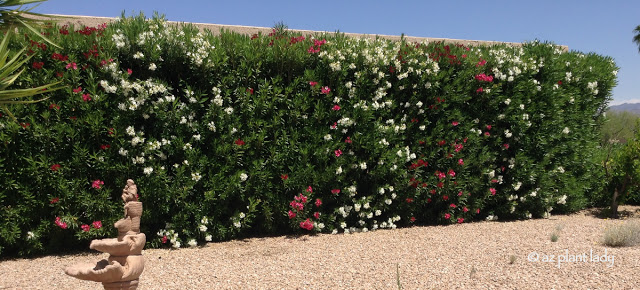
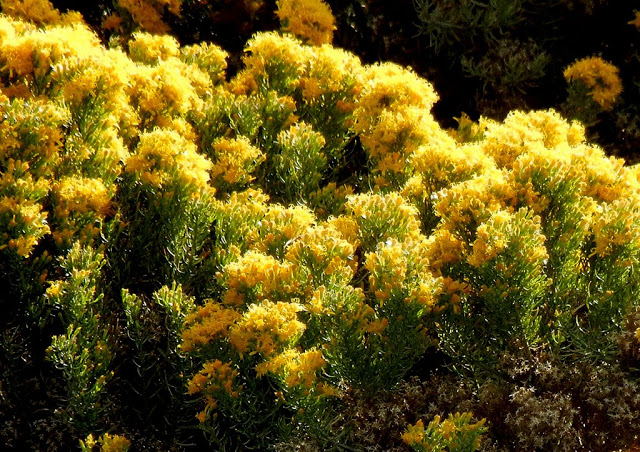
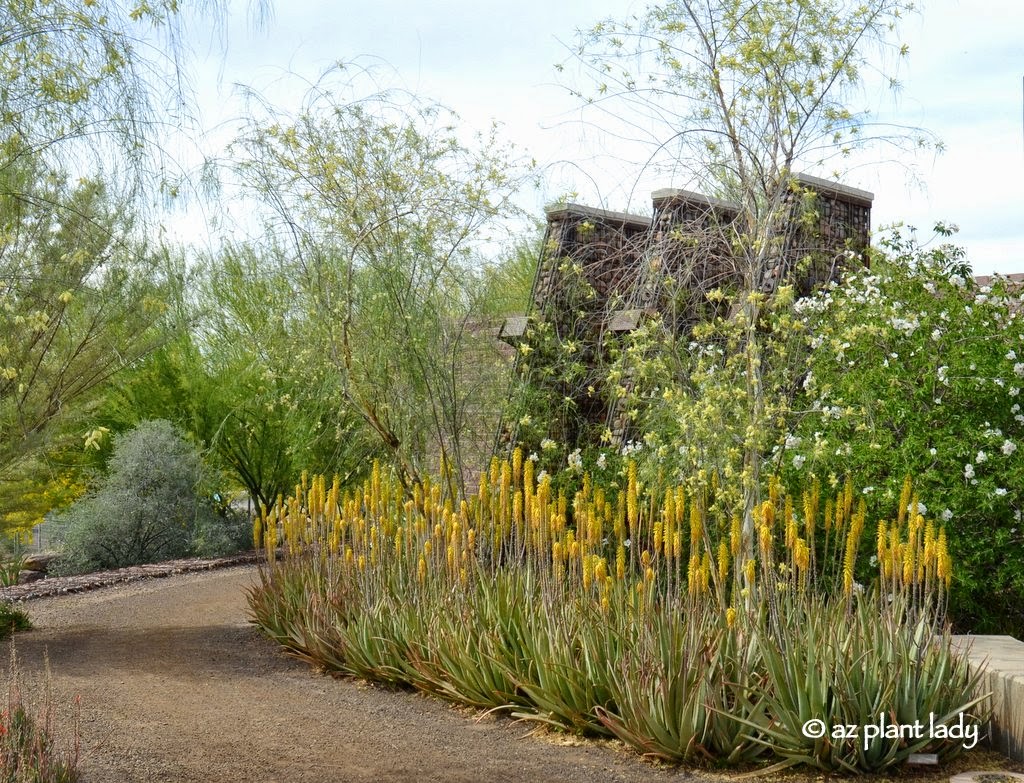
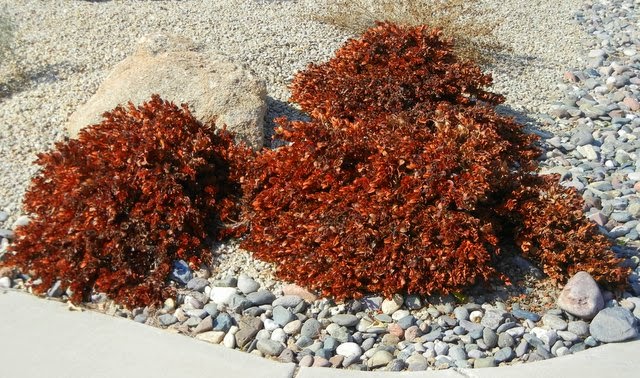










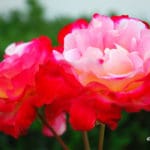
This is one of most common shrubs in our hot climate. We have probably 3 colors. yellow, orange and another orange. all are blooming vigorously right now. great pics and thanks for sharing. Strangely yellow one is not much common here as compared to orange one 😛
I PRUNED MY POTTED YELLOW BELL BEFORE THE COLD WEATHER AND TO THIS DAY IT HAS NOT SHOWN ANY LIFE. MY ORANGE BELLS HAS PRODUCED LEAVES AND SHOWING SOME BUDS. WHAT IS WRONG WITH MY YELLOW BELL. IT LOOKS DEAD.
Hello,
Yellow and orange bells should be pruned in early spring. If they are pruned in the fall or in winter, they are much more susceptible to damage from freezing temperatures. I suspect that is what happened to your yellow bells shrubs.
My yellow bells were planted in march. I live in Nevada. Initially they did great and bloomed several times. Then they started dying of several months later. I planted with nutrient soil. Is they get 50-50 sun. Is there something I did wrong? I started with small drip then increased. I saw them dying then cut them back on watering. I really want some yellow bells in my yard.
My yellow bells were planted in march. I live in Nevada. Initially they did great and bloomed several times. Then they started dying of several months later. I planted with nutrient soil. Is they get 50-50 sun. Is there something I did wrong? I started with small drip then increased. I saw them dying then cut them back on watering. I really want some yellow bells in my yard. Can you email me back? Thank you
Hi Judy,
Yellow bells, as with most plants, do best when planted in fall so they have several months to grow a good root system before the summer heat arrives. They don’t need rich soil and do well in native soil in most cases. In regards to watering, here is a link to recommended watering schedule for the greater Phoenix area, which would be similar to Las Vegas – http://www.amwua.org/pdfs/landscape_watering_guidelines.pdf I recommend starting with the high-water use category for shrubs. I hope this helps!
My yellow bells have always bloomed for about 10 years, I did notice last year less blooms but it did bloom, it only bloomed once this year and two blooms each plant. What should I do or feed it to get it to bloom? Please advise me. thanks Joanne
Hi Joanne,
Like people, plants can get old and don’t do as well. Sometimes, severe rejuvenation pruning works well, which should be done in early spring by pruning it back to 1 foot tall and wide. Usually, yellow bells respond by growing back fairly quickly. If however, after a few weeks it has not, it means that it is declining due to age and you can pull it out and plant a new one.
We moved to Paradise Valley AZ a few years ago from Minneapolis MN. Our 1961 vintage house had 3 large yellow bells planted about a foot from a block wall fence. The plants face south and have one drip emitter installed. I didn’t know a thing about the plants and after the first freeze cut them back as they looked horrible, all brown and dead foliage. They came back. Last year as soon as they stopped producing blooms in the fall I cut them back to one foot. There were many older “canes” which I cut out. The younger canes came back and the plants bloomed with great vigor and grew above the wall in height. I can’t remember for sure, but think I tossed down fertilizer around the area. The hummingbirds are still feeding so leaving the plants as is for now. These must be older varieties and quite hardy although frost sensitive. If we get a freeze this year, I’ll cut them back again. We bought 3 more newer variety, “Sparky” at the DBG sale this fall which do not produce litter, are compact in form. Named for the ASU’s mascot they are two colored. These plants remind me of lilacs in the north which need rejuvenation by severe pruning now and then. Great color for the Valley.
How big or long are the roots of yellow trumpets?
Hello Bruce,
While I cannot tell you for certain how large the roots are, they aren’t known for being invasive or for causing problems with cracking walls or uplifting pavement. They have a typical shrub root system. I hope this helps!
Today is October 30th and I live in Mesa Az Is it to late to prune back I have yellow and orange bells and they still have flowers. I dont wanna take a chance on damaging them if so I would rather wait till???? Spring??
Hello Eddie,
It is too late to prune them back now. Doing so will promote new growth that is especially susceptible to damage from frost and a very cold winter may kill your plant. Wait until early March when the danger of frost has passed. 🙂